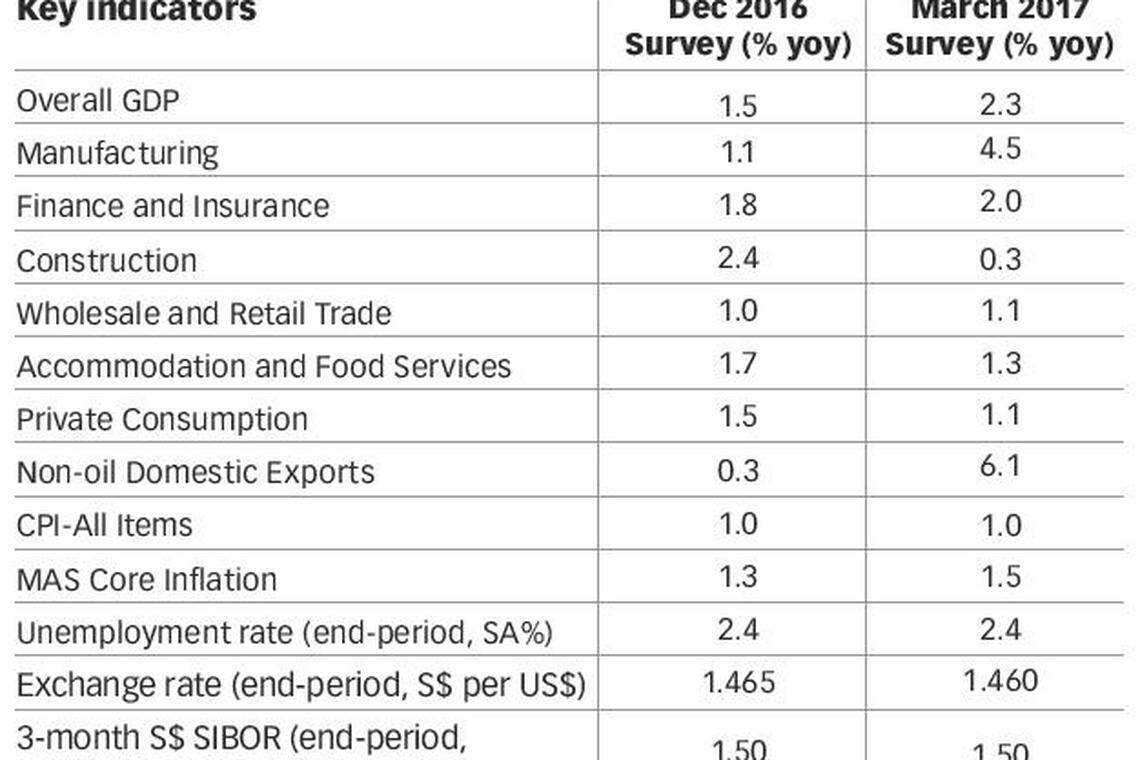Brighter outlook for Singapore's trade-dependent sectors, dimmer prospects at home
Economists say they will revise growth forecasts up but are divided on how broad-based growth can be
Singapore
A TWO-SPEED economy has emerged in Singapore, going by the latest survey among private-sector economists, the results of which were released on Wednesday.
At least for now, they agree that external-facing indicators are strong enough to warrant their revising growth rates upwards from the previous survey.
They also agree that domestic-oriented indicators are weaker, as reflected by the weak labour market data, also released on Wednesday.
But even as they agreed on the growth dichotomy, they were divided on how broad-based growth can be.
Mizuho Bank economist Vishnu Varathan said of the survey results: "The risks at the margins have diminished, but domestically, there has been some disappointment."
In the survey conducted by the Monetary Authority of Singapore (MAS) in mid-February, private-sector economists said the Singapore economy will grow by 2.6 per cent in the first quarter of 2017, and 2.3 per cent for the whole year.
When polled in December last year, they had said there would be only 1.3 per cent growth for the first quarter this year, and 1.5 per cent growth for full year.
MAS said that from the 23 responses collected, the economy is likely to grow by between 2 and 2.9 per cent this year, above the earlier 1 to 1.9 per cent range.

The quarterly survey offers more of an overview of where private-sector economists see the economy heading and how they arrive at their conclusions, rather than an indication of where the economy might be headed.
Even so, the strength in the upward revisions between the last MAS survey and the latest one indicates the soundness - and unanimity - of their near-term optimism.
Wednesday's 2.3 per cent full-year growth for 2017 was the first upward revision for the year since the survey respondents first forecast the number in March 2016.
The 2.3 per cent forecast is a median one, close to the mean forecast of 2.2 per cent. This means that many of the 23 responses were distributed around the same number, with more of them higher than the mean forecast of 2.2 per cent.
Economists that The Business Times spoke to attributed the strong upward revision in the March 2017 survey to better external prospects for Singapore's trade-reliant economy.
Not only is China's growth on a more stable footing, the new US administration's promise of fiscal stimulus has also encouraged investors.
Non-oil domestic exports are therefore expected to rise by 6.1 per cent in 2017, much stronger than the 0.3 per cent forecast earlier.
Manufacturing is among the sectors to ride this wave. With it posting surprisingly strong growth late last year, the survey respondents expect the momentum to carry into this year.
The sector accounts for much of the upward revision in the March 2017 survey. Respondents now expect the sector to grow by 4.5 per cent this year, up from the 1.1 per cent growth predicted in the December 2016 survey.
Nomura economist Brian Tan said: "Demand for Singapore's manufacturing output is also reflected in a lot of the Asian economies' data, so it looks now that the sector's growth has legs, and it can be sustained for a while."
Oil-related segments have benefited from recovering commodity prices too, thus lifting manufacturing growth, said Mizuho's Mr Varathan.
In contrast to the stronger numbers for the external-facing segments, respondents in the March 2017 survey toned down their expectations for domestic-facing segments.
The construction sector is expected to grow by only 0.3 per cent, down from 2.4 per cent earlier. Accommodation and food services are expected to grow by 1.3 per cent this year, lower than the previous 1.7 per cent. Private consumption will only rise by 1.1 per cent, compared to the 1.5 per forecast earlier.
But even as respondents noted the diverging trends in Singapore's economy, they also had diverging views on how long the growth may last.
In the absence of better broad-based numbers, Nomura's Mr Tan was sceptical about the sustainability of the manufacturing-led growth.
"Manufacturing employment numbers have come down, so the strong sectoral data doesn't look like the kind of thing that is a natural outcome of stronger growth," he said.
But DBS economist Irvin Seah was more sanguine. He predicts that the spillover from the stronger segments into weaker ones will occur this year.
Pointing to Wednesday's labour market data that showed higher unemployment and layoffs, Mr Seah said that it may point towards a bottoming out of labour-market woes.
"It's a lagging indicator," he said, adding that manufacturing growth will soon lift the labour market, which is a second-degree indicator. The retail and food-and-beverage sectors will then benefit as workers are more confident.
"The strong showing in the manufacturing sector is an initial sign of stronger growth."
BT is now on Telegram!
For daily updates on weekdays and specially selected content for the weekend. Subscribe to t.me/BizTimes
International
S&P downgrades Israel rating on heightened geopolitical risk
‘We have our jury’: panel selected for Trump criminal trial
UK wage growth and services inflation too high for rate cut, BOE’s Greene says
US to reduce licensing by 80% for UK, Australia to boost Aukus
IMF tells Asian central banks not to follow Fed too closely
UN chief warns Mideast on brink of 'full-scale regional conflict'
